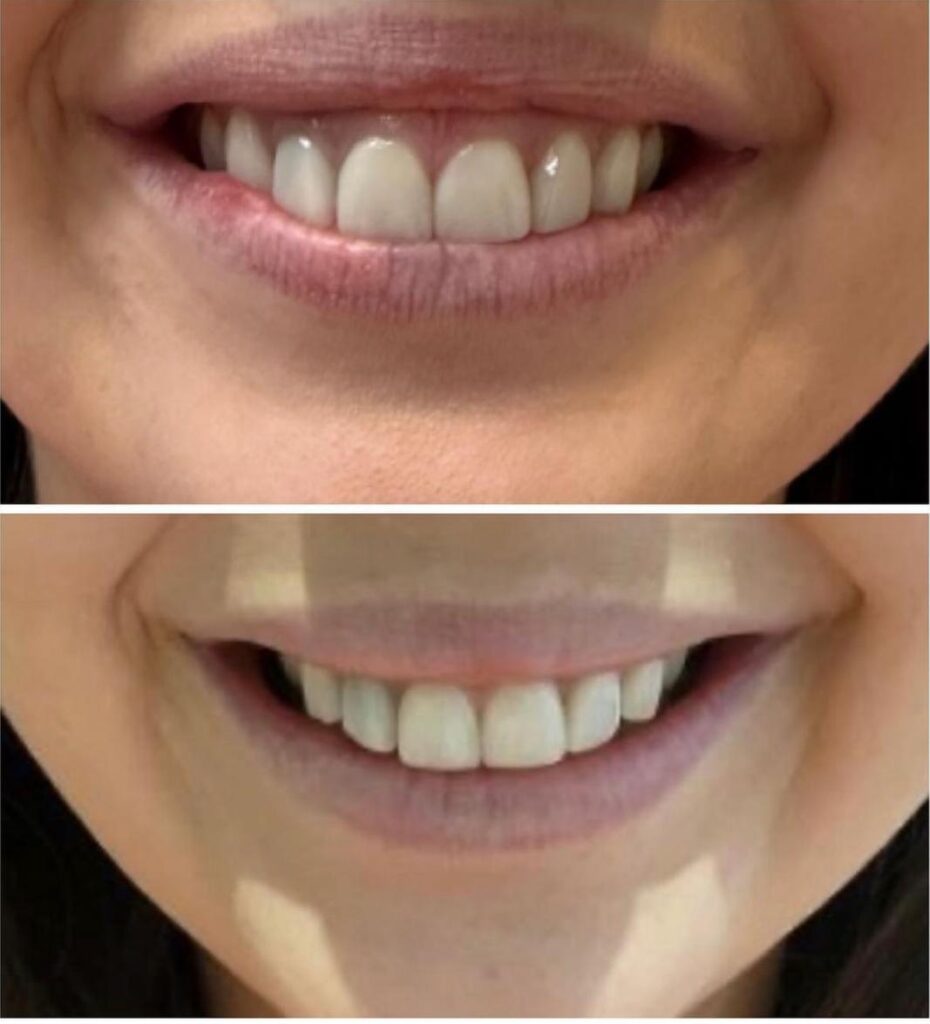Introduction
A gummy smile is a dental condition where a significant amount of gum tissue is visible when a person smiles. While some people embrace their gummy smile as a unique trait, others may feel self-conscious and seek means to address it. In this article, we will explore the causes of a gummy smile, various treatment options, and address frequently asked questions to help individuals gain a better understanding of this condition.
Causes of a Gummy Smile
A gummy smile can stem from various factors, including dental and skeletal factors, muscular factors, and psychological factors.
Dental and Skeletal Factors
- Excessive gum tissue: Some individuals naturally have an excessive amount of gum tissue, leading to a higher gum-to-tooth ratio and a gummy smile.
- Abnormal tooth eruption: Teeth that don’t fully erupt can contribute to a gummy smile as the gum tissue covers a larger portion of the tooth.
- Short upper lip: A short upper lip can reveal more gum tissue when smiling, making the smile appear gummy.
Muscular Factors
- Overactive upper lip muscles: The muscles responsible for lifting the upper lip may be overactive, causing excessive gum display when smiling.
- Hyperactive elevator muscles: Muscles that elevate the upper lip excessively can also contribute to a gummy smile.
- Other contributing muscle-related causes: Certain facial muscle imbalances or abnormalities can affect lip and smile dynamics, resulting in a gummy appearance.
Psychological Factors
- Emotional factors related to a Gummy Smile: Individuals with a gummy smile may experience feelings of self-consciousness, leading to a negative impact on their emotional well-being.
- The role of social media influence: The prevalence of social media platforms may amplify self-image concerns. Constant exposure to picture-perfect smiles can make those with a gummy smile even more conscious of their appearance.

Diagnosing a Gummy Smile
To diagnose a gummy smile, dental professionals employ various assessment methods, including clinical assessment, imaging and technology, and collaboration between dental specialists.
Clinical Assessment
- Measurement of gingival display: Dentists measure the amount of gum tissue visible during a smile to determine the severity of the gummy smile.
- Evaluating tooth proportion and alignment: Dentists assess the position and alignment of the teeth to identify any underlying dental issues contributing to the gummy smile.
- Assessing facial symmetry: Examining the symmetry of the face helps determine whether facial proportions play a role in the gummy smile.
Imaging and Technology
- Digital smile design: Dentists use computer software to visualise potential treatment outcomes and design a customised treatment plan accordingly.
- Orthodontic analysis: Utilising orthodontic analysis software, dentists evaluate the relationship between the teeth, jaw, and gums.
- Use of X-rays and 3D imaging: X-rays and three-dimensional imaging techniques allow for a more comprehensive evaluation of the dental and skeletal structures, aiding in accurate diagnosis.
Collaboration between Dental Specialists
- Roles of periodontists, orthodontists, and oral surgeons: Collaboration between different dental specialists ensures a holistic approach to diagnosing and treating a gummy smile. Periodontists focus on the gum tissue, orthodontists address tooth and jaw alignment, and oral surgeons perform surgical procedures if required.
- Importance of multidisciplinary consultations: A multidisciplinary consultation involving dental specialists helps accurately diagnose the underlying causes of a gummy smile and develop an effective treatment plan.
- Treatment planning based on diagnostic findings: The diagnostic findings guide the dental team in creating a personalised treatment plan tailored to the individual’s specific needs.
Treatment Options for a Gummy Smile
Addressing a gummy smile can involve both non-surgical and surgical treatments, depending on the underlying causes and severity.
Non-Surgical Treatments
- Orthodontic methods: Orthodontic treatments, such as braces or clear aligners, can help correct misaligned teeth and reduce excessive gum display.
- Gingivectomy and crown lengthening: These procedures involve removing or reshaping excess gum tissue to achieve a balanced gum-to-tooth ratio.
- Anti-wrinkle injections to relax hyperactive muscles: Anti-Wrinkle injections can be used to temporarily weaken the muscles responsible for lifting the upper lip, reducing gum exposure during smiling.
Surgical Treatments
- Orthognathic surgery to reposition the jaw: In cases where the gummy smile is caused by skeletal factors, orthognathic surgery may be recommended to reposition the jaw and correct the underlying skeletal imbalance.
- Lip repositioning techniques: Surgical procedures can be performed to modify the position of the upper lip, reducing the amount of gum tissue visible during a smile.
- Importance of customising surgical approaches: Each individual’s gummy smile is unique, requiring a customised surgical approach to address the underlying causes effectively.
Alternative and Complementary Options
- Laser therapy for gum contouring: Laser treatments can precisely reshape the gum line, achieving a more aesthetically pleasing smile.
- Lip exercises and myofunctional therapy: Certain exercises and therapies can help improve lip muscle control, reducing gum display during smiling.
- Platelet-rich plasma treatment’s role in tissue regeneration: Platelet-rich plasma therapy stimulates tissue regeneration, promoting gum health and potentially reducing the appearance of a gummy smile.

Recovery and Post-Treatment Care
A proper recovery and post-treatment care routine is essential for successful treatment of a gummy smile. Each of the above options carry their own recovery and aftercare.
Managing Discomfort and Swelling
- Pain management strategies: Dentists may prescribe pain medications or recommend over-the-counter pain relievers to manage post-treatment discomfort.
- Cold compress and swelling reduction techniques: Applying a cold compress to the treated area can help minimise swelling and aid in the healing process.
- Post-operative medication and follow-up appointments: Adhering to prescribed medications and attending follow-up appointments allows the dental team to monitor the progress of the treatment and address any concerns.
Maintaining Oral Health
- Oral hygiene practices after treatment: Dentists provide specific instructions on how to maintain oral hygiene after treatment, including proper brushing, flossing, and using prescribed mouth rinses.
- Dietary considerations for optimal healing: Following a soft food diet and avoiding hard, chewy foods can promote healing and minimise discomfort during the recovery period.
- Follow-up consultations and monitoring progress: Regular follow-up appointments allow the dental team to assess the progress of the treatment and make any necessary adjustments.
FAQs
Addressing common concerns about gummy smile treatment can provide clarity and reassurance to individuals considering treatment.
Yes, a gummy smile can have a hereditary component. Genetic factors can play a role in the development of excessive gum tissue, abnormal tooth eruption, and other skeletal or muscular causes of a gummy smile.
Insurance coverage for gummy smile treatment varies. Some dental insurance plans may cover certain treatment options if they are deemed medically necessary. It is advisable to check with the insurance provider regarding coverage details.
While treatment for a gummy smile is generally safe, there are potential risks and complications, depending on the chosen treatment option. These can be discussed in detail with the dental professional during the consultation phase.
The duration of the treatment process for a gummy smile depends on several factors, including the chosen treatment option, individual healing ability, and any pre-existing dental conditions. The dental team will provide an estimated timeline specific to each individual’s treatment plan.
In some cases, a gummy smile may recur after treatment, particularly if the underlying causes were not fully addressed. Regular follow-up appointments and maintaining good oral hygiene practices can help prevent a gummy smile from returning.
Summary and Conclusion
Understanding the causes, treatment options, and frequently asked questions about a gummy smile can empower individuals to make informed decisions about their oral health and well-being. Seeking professional advice and collaborating with a dental team will ensure a personalised treatment plan that can potentially enhance self-confidence and improve quality of life. Remember, building self-confidence through effective treatment options is entirely possible, leading to a beautiful, confident smile.



